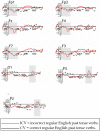An Event-related Potential Study of Second Language Semantic and Syntactic Processing: Evidence From the Declarative/Procedural Model
- PMID: 33850621
- PMCID: PMC8019844
- DOI: 10.32598/bcn.11.6.2401.1
An Event-related Potential Study of Second Language Semantic and Syntactic Processing: Evidence From the Declarative/Procedural Model
Abstract
Introduction: This study examined the effect of proficiency level on the second Language (L2) syntactic and semantic processing by addressing the role of procedural and declarative memory systems in light of the Declarative/Procedural (DP) model. The primary purpose was to determine to what extent proficiency accounts for native-like language processing in L2 in adult bilinguals who learned English (L2) after the age of 15 under explicit instruction.
Methods: Using a mixed-method design and an oddball violation paradigm, we examined the functional neural correlates of syntactic and semantic processing in two groups of Persian-English bilinguals (L1=Persian, L2=English; N=10 high-proficient, N=10 pre-intermediate levels; Gender= Female; mean age=25.50 years, SD = 5.09 years, age range = 19-35 years of age) across 6 different conditions. They included a visual stimulus task of 240 English sentences with three different experimental conditions (violated regular past forms or phrase structure rules or final-word semantic violation) and three control conditions (sets of correct sentences for each experimental condition). Both groups started learning English late (age of onset=15+) and under an explicit learning context. To evaluate the effect of L2 proficiency, Event-related potentials (ERPs) to target words in each condition were elicited across the N400 time window (300-500 ms) and the P600 time window (500-700 ms).
Results: Results showed different cortical responses in the two groups. Upon processing the violated forms, high-proficient subjects showed more native-like patterns of scalp activity in both lexical-semantic and syntactic processing. In contrast, less proficient learners have shown delayed onsets and or peaks of components, reduced amplitudes, or absent components in some regions. For instance, the difference in N400 amplitude for the incorrect regular past conditions was observed only in the pre-intermediate (PI) subjects in the O1 channel. This finding is compatible with the DP Model in that at lower levels of L2 proficiency, the participants show N400s or N400-like posterior negativities instead of Anterior Negativities (ANs). This finding shows the initial reliance on the declarative memory system for syntactic processing at lower levels of L2.
Conclusion: Our findings suggest that attained proficiency was a more determinant factor in the L1-like cortical representation of L2 than the age of acquisition and or the type of instruction/context. Several brain areas, similar to those observed for L1, were activated during L2 syntactic processing in high-proficient subjects addressing their reliance on the procedural memory system for syntactic processing to gain more proficiency. For instance, our results showed a significant difference in N400 amplitude for the incorrect regular past conditions in O1 for the PI subjects, which shows the initial reliance on the declarative memory system for syntactic processing at lower levels of L2.
Keywords: Event Related Potentials; Language proficiency; Semantic; Speech processing; Syntax.
Copyright© 2020 Iranian Neuroscience Society.
Conflict of interest statement
Conflict of interest The authors declared no conflict of interest.
Figures









References
-
- Anderson J. R. (1993). Rules of the mind. Mahwah, NJ: Lawrence Erlbaum Associates Inc. https://books.google.com/books?id=1KOYAgAAQBAJ&printsec=frontcover&dq
-
- Anderson J. R. (2013). The architecture of cognition. New York: Psychology Press. [DOI:10.4324/9781315799438] - DOI
-
- Brill-Schuetz K., Morgan-Short K. (2014). The role of procedural memory in adult second language acquisition. In. Proceedings of the Annual Meeting of the Cognitive Science Society, 36(36), 1–7. https://escholarship.org/content/qt0dc7958r/qt0dc7958r.pdf
-
- DeKeyser R. (2007). Practice in a second language: Perspectives from applied linguistics and cognitive psychology. Cambridge: Cambridge University Press. [DOI:10.1017/CBO9780511667275] - DOI
-
- Díaz B., Erdocia K., de Menezes R. F., Mueller J. L., Sebastián-Gallés N., Laka I. (2016). Electrophysiological correlates of second-language syntactic processes are related to native and second language distance regardless of age of acquisition. Frontiers in Psychology, 7, 133. [DOI:10.3389/fpsyg.2016.00133] [PMID https://www.ncbi.nlm.nih.gov/pubmed/26903930] [PMCID http://www.ncbi.nlm.nih.gov/pmc/articles/PMC4751279] - DOI - PMC - PubMed
LinkOut - more resources
Full Text Sources
Research Materials
Miscellaneous
